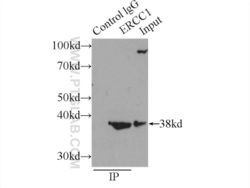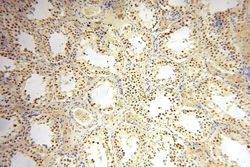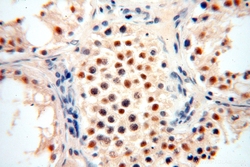Antibody data
- Antibody Data
- Antigen structure
- References [19]
- Comments [0]
- Validations
- Western blot [1]
- Immunoprecipitation [1]
- Immunohistochemistry [2]
Submit
Validation data
Reference
Comment
Report error
- Product number
- 14586-1-AP - Provider product page

- Provider
- Proteintech Group
- Proper citation
- Proteintech Cat#14586-1-AP, RRID:AB_2100027
- Product name
- ERCC1 antibody
- Antibody type
- Polyclonal
- Description
- KD/KO validated ERCC1 antibody (Cat. #14586-1-AP) is a rabbit polyclonal antibody that shows reactivity with human, mouse, rat and has been validated for the following applications: IF, IHC, IP, WB,ELISA.
- Reactivity
- Human, Mouse, Rat
- Host
- Rabbit
- Conjugate
- Unconjugated
- Isotype
- IgG
- Vial size
- 20ul, 150ul
Submitted references Harmine inhibits pulmonary fibrosis through regulating DNA damage repair-related genes and activation of TP53-Gadd45α pathway.
Enhancing precision medicine: a nomogram for predicting platinum resistance in epithelial ovarian cancer.
D-type cyclins regulate DNA mismatch repair in the G1 and S phases of the cell cycle, maintaining genome stability.
CDK-independent role of D-type cyclins in regulating DNA mismatch repair.
Mechanistic study of lncRNA UCA1 promoting growth and cisplatin resistance in lung adenocarcinoma.
Synergistic effects of olaparib combined with ERCC1 on the sensitivity of cisplatin in non-small cell lung cancer.
The AKT/GSK3-Mediated Slug Expression Contributes to Oxaliplatin Resistance in Colorectal Cancer via Upregulation of ERCC1.
Sulforaphane enhances the cisplatin sensitivity through regulating DNA repair and accumulation of intracellular cisplatin in ovarian cancer cells.
Severe ineffective erythropoiesis discriminates prognosis in myelodysplastic syndromes: analysis based on 776 patients from a single centre.
CLEC4M is associated with poor prognosis and promotes cisplatin resistance in NSCLC patients.
Berberine attenuates XRCC1-mediated base excision repair and sensitizes breast cancer cells to the chemotherapeutic drugs.
Dehydrogenase/reductase SDR family member 2 silencing sensitizes an oxaliplatin‑resistant cell line to oxaliplatin by inhibiting excision repair cross‑complementing group 1 protein expression.
MEK inhibitor enhanced the antitumor effect of oxaliplatin and 5‑fluorouracil in MEK1 Q56P‑mutant colorectal cancer cells.
PFKFB3 blockade inhibits hepatocellular carcinoma growth by impairing DNA repair through AKT.
Functional characterization of a novel transcript of ERCC1 in chemotherapy resistance of ovarian cancer.
Aberrant methylation of nucleotide excision repair genes is associated with chronic arsenic poisoning.
Chemosensitizing effect of shRNA-mediated ERCC1 silencing on a Xuanwei lung adenocarcinoma cell line and its clinical significance.
Establishment of a first-line second-line treatment model for human pulmonary adenocarcinoma.
Polychlorinated biphenyl quinone induces oxidative DNA damage and repair responses: The activations of NHEJ, BER and NER via ATM-p53 signaling axis.
Gong Y, Wang J, Pan M, Zhao Y, Zhang H, Zhang F, Liu J, Yang J, Hu J
International immunopharmacology 2024 Sep 10;138:112542
International immunopharmacology 2024 Sep 10;138:112542
Enhancing precision medicine: a nomogram for predicting platinum resistance in epithelial ovarian cancer.
Li R, Xiong Z, Ma Y, Li Y, Yang Y, Ma S, Ha C
World journal of surgical oncology 2024 Mar 21;22(1):81
World journal of surgical oncology 2024 Mar 21;22(1):81
D-type cyclins regulate DNA mismatch repair in the G1 and S phases of the cell cycle, maintaining genome stability.
Rona G, Miwatani-Minter B, Zhang Q, Goldberg HV, Kerzhnerman MA, Howard JB, Simoneschi D, Lane E, Hobbs JW, Sassani E, Wang AA, Keegan S, Laverty DJ, Piett CG, Pongor LS, Xu ML, Andrade J, Thomas A, Sicinski P, Askenazi M, Ueberheide B, Fenyö D, Nagel ZD, Pagano M
bioRxiv : the preprint server for biology 2024 Jan 13;
bioRxiv : the preprint server for biology 2024 Jan 13;
CDK-independent role of D-type cyclins in regulating DNA mismatch repair.
Rona G, Miwatani-Minter B, Zhang Q, Goldberg HV, Kerzhnerman MA, Howard JB, Simoneschi D, Lane E, Hobbs JW, Sassani E, Wang AA, Keegan S, Laverty DJ, Piett CG, Pongor LS, Xu ML, Andrade J, Thomas A, Sicinski P, Askenazi M, Ueberheide B, Fenyö D, Nagel ZD, Pagano M
Molecular cell 2024 Apr 4;84(7):1224-1242.e13
Molecular cell 2024 Apr 4;84(7):1224-1242.e13
Mechanistic study of lncRNA UCA1 promoting growth and cisplatin resistance in lung adenocarcinoma.
Fu J, Pan J, Yang X, Zhang Y, Shao F, Chen J, Huang K, Wang Y
Cancer cell international 2021 Sep 20;21(1):505
Cancer cell international 2021 Sep 20;21(1):505
Synergistic effects of olaparib combined with ERCC1 on the sensitivity of cisplatin in non-small cell lung cancer.
Xie K, Ni X, Lv S, Zhou G, He H
Oncology letters 2021 May;21(5):365
Oncology letters 2021 May;21(5):365
The AKT/GSK3-Mediated Slug Expression Contributes to Oxaliplatin Resistance in Colorectal Cancer via Upregulation of ERCC1.
Wei W, Ma XD, Jiang GM, Shi B, Zhong W, Sun CL, Zhao L, Hou YJ, Wang H
Oncology research 2020 Sep 1;28(4):423-438
Oncology research 2020 Sep 1;28(4):423-438
Sulforaphane enhances the cisplatin sensitivity through regulating DNA repair and accumulation of intracellular cisplatin in ovarian cancer cells.
Gong TT, Liu XD, Zhan ZP, Wu QJ
Experimental cell research 2020 Aug 15;393(2):112061
Experimental cell research 2020 Aug 15;393(2):112061
Severe ineffective erythropoiesis discriminates prognosis in myelodysplastic syndromes: analysis based on 776 patients from a single centre.
Huang H, Xu C, Gao J, Li B, Qin T, Xu Z, Ren S, Zhang Y, Jiao M, Qu S, Pan L, Hu N, Liu J, Cai W, Zhang Y, Wu D, Zhang P, Gale RP, Huang G, Zhou J, Shi L, Xiao Z
Blood cancer journal 2020 Aug 14;10(8):83
Blood cancer journal 2020 Aug 14;10(8):83
CLEC4M is associated with poor prognosis and promotes cisplatin resistance in NSCLC patients.
Tan LM, Li X, Qiu CF, Zhu T, Hu CP, Yin JY, Zhang W, Zhou HH, Liu ZQ
Journal of Cancer 2019;10(25):6374-6383
Journal of Cancer 2019;10(25):6374-6383
Berberine attenuates XRCC1-mediated base excision repair and sensitizes breast cancer cells to the chemotherapeutic drugs.
Gao X, Wang J, Li M, Wang J, Lv J, Zhang L, Sun C, Ji J, Yang W, Zhao Z, Mao W
Journal of cellular and molecular medicine 2019 Oct;23(10):6797-6804
Journal of cellular and molecular medicine 2019 Oct;23(10):6797-6804
Dehydrogenase/reductase SDR family member 2 silencing sensitizes an oxaliplatin‑resistant cell line to oxaliplatin by inhibiting excision repair cross‑complementing group 1 protein expression.
Li JM, Jiang GM, Zhao L, Yang F, Yuan WQ, Wang H, Luo YQ
Oncology reports 2019 Nov;42(5):1725-1734
Oncology reports 2019 Nov;42(5):1725-1734
MEK inhibitor enhanced the antitumor effect of oxaliplatin and 5‑fluorouracil in MEK1 Q56P‑mutant colorectal cancer cells.
Jing C, Li H, Du Y, Cao H, Liu S, Wang Z, Ma R, Feng J, Wu J
Molecular medicine reports 2019 Feb;19(2):1092-1100
Molecular medicine reports 2019 Feb;19(2):1092-1100
PFKFB3 blockade inhibits hepatocellular carcinoma growth by impairing DNA repair through AKT.
Shi WK, Zhu XD, Wang CH, Zhang YY, Cai H, Li XL, Cao MQ, Zhang SZ, Li KS, Sun HC
Cell death & disease 2018 Apr 1;9(4):428
Cell death & disease 2018 Apr 1;9(4):428
Functional characterization of a novel transcript of ERCC1 in chemotherapy resistance of ovarian cancer.
Liu J, Zhang L, Mao P, Jiang G, Liu L, Wang J, Yang W, Owusu L, Li W
Oncotarget 2017 Oct 17;8(49):85759-85771
Oncotarget 2017 Oct 17;8(49):85759-85771
Aberrant methylation of nucleotide excision repair genes is associated with chronic arsenic poisoning.
Zhang A, Li H, Xiao Y, Chen L, Zhu X, Li J, Ma L, Pan X, Chen W, He Z
Biomarkers : biochemical indicators of exposure, response, and susceptibility to chemicals 2017 Jul;22(5):429-438
Biomarkers : biochemical indicators of exposure, response, and susceptibility to chemicals 2017 Jul;22(5):429-438
Chemosensitizing effect of shRNA-mediated ERCC1 silencing on a Xuanwei lung adenocarcinoma cell line and its clinical significance.
Wang W, Zhang L, Liu L, Zheng Y, Zhang Y, Yang S, Shi R, Wang S
Oncology reports 2017 Apr;37(4):1989-1997
Oncology reports 2017 Apr;37(4):1989-1997
Establishment of a first-line second-line treatment model for human pulmonary adenocarcinoma.
Wang L, Wang Y, Guan Q, Liu Y, He T, Wang J
Oncology letters 2016 Dec;12(6):4461-4466
Oncology letters 2016 Dec;12(6):4461-4466
Polychlorinated biphenyl quinone induces oxidative DNA damage and repair responses: The activations of NHEJ, BER and NER via ATM-p53 signaling axis.
Dong H, Shi Q, Song X, Fu J, Hu L, Xu D, Su C, Xia X, Song E, Song Y
Toxicology and applied pharmacology 2015 Jul 1;286(1):10-6
Toxicology and applied pharmacology 2015 Jul 1;286(1):10-6
No comments: Submit comment
Supportive validation
- Submitted by
- Proteintech Group (provider)
- Main image

- Experimental details
- MCF7 cells were subjected to SDS PAGE followed by western blot with 14586-1-AP(ERCC1 antibody) at dilution of 1:300
- Sample type
- cell line
Supportive validation
- Submitted by
- Proteintech Group (provider)
- Main image

- Experimental details
- IP Result of anti-ERCC1 (IP:14586-1-AP, 3ug; Detection:14586-1-AP 1:300) with MCF-7 cells lysate 1600ug.
- Sample type
- cell line
Supportive validation
- Submitted by
- Proteintech Group (provider)
- Main image

- Experimental details
- Immunohistochemical of paraffin-embedded human testis using 14586-1-AP(ERCC1 antibody) at dilution of 1:50 (under 10x lens)
- Sample type
- tissue
- Submitted by
- Proteintech Group (provider)
- Main image

- Experimental details
- The ERCC1 antibody from Proteintech is a rabbit polyclonal antibody to a recombinant protein of human ERCC1. This antibody recognizes human,mouse,rat antigen. The ERCC1 antibody has been validated for the following applications: ELISA, WB, IHC, IP analysis.
 Explore
Explore Validate
Validate Learn
Learn Western blot
Western blot ELISA
ELISA